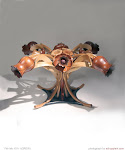This project involved replacing a piece of decorative vine missing from this 20th century gilt mirror frame. The lost area is indicated in the photo above with two red arrows. A clear representation of the missing area was located (by the single red arrow above) to provide a copy. Visual analysis of the original frame construction indicated a .5" wooden backing adhered to a cast decorative front. This surface was finished with oil gilded gold leaf.
 The approach used in this repair involved re-creating the processes of its original construction. First I traced an outline of the sample area on a .5" thick piece of balsa wood, and then cut the design out with a band saw. A mold impression of the top surface sample area was then made using a two part mold making material (silicone rubber). A cast of this mold was then made using a two part epoxy putty. This piece was sanded flat on the back prior to adhering the mold to the wood substrate, then shaped to remove excess material . This joined piece was then glued to the frame. The replacement piece was easily isolated so no gilding overlap would occur. I chose a traditional oil gilding size manufavtured by Le Franc & Bourgeois and 23.75 K Italian gold leaf. After the size had reached an appropriate tack the leaf was adhered and allowed to set thoroughly before a sealer coat of shellac was applied. The newly gilt area was then toned to match its surroundings using an oil based glaze and marble dust.
The approach used in this repair involved re-creating the processes of its original construction. First I traced an outline of the sample area on a .5" thick piece of balsa wood, and then cut the design out with a band saw. A mold impression of the top surface sample area was then made using a two part mold making material (silicone rubber). A cast of this mold was then made using a two part epoxy putty. This piece was sanded flat on the back prior to adhering the mold to the wood substrate, then shaped to remove excess material . This joined piece was then glued to the frame. The replacement piece was easily isolated so no gilding overlap would occur. I chose a traditional oil gilding size manufavtured by Le Franc & Bourgeois and 23.75 K Italian gold leaf. After the size had reached an appropriate tack the leaf was adhered and allowed to set thoroughly before a sealer coat of shellac was applied. The newly gilt area was then toned to match its surroundings using an oil based glaze and marble dust.





















